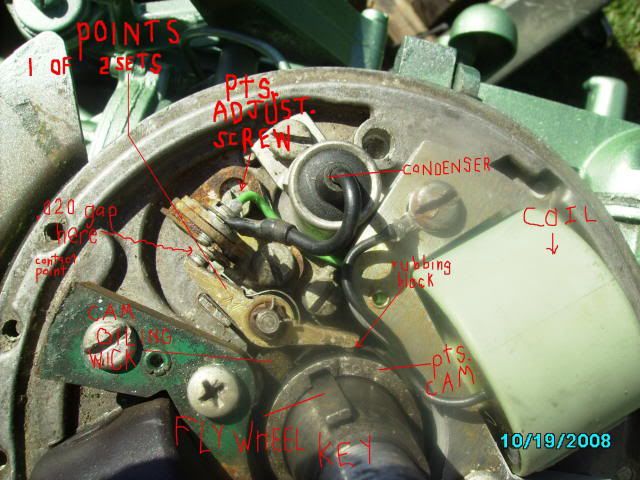Carburetor: To remove the carburetor, you will need to disconnect the fuel line, the choke lever & low speed knob. This knob just pulls off the finely splined shaft straight forward. After that, you will have to then remove the two top bolts (using a 5/16" box wrench) from the recoil spool mounting plate. Very carefully pull the complete starter to one side just so far that do not pull the recoil spring out of the base. You now have to remove the screw holding the carburetor cam linkage off the carburetor. Now you can get a 7/16" wrench onto the LH carburetor mounting nut & remove that nut. Replace the starter unit & bolt it back in to keep the spool & the spring from coming a nightmare. Remove the RH carburetor nut, slide the carburetor forward off mounting studs.
The carburetor is the basic simple standard unit & from about 1971 on the main-jet is a fixed one. Earlier motors prior to about 1970 had an adjustable main-jet. You will have to loosen & remove the rewind starter spool so you can get to the throttle lever pivot nut so you can then get a wrench on the port side carburetor nut.
You can usually tear the carburetor apart, soak it in a carburetor cleaner overnight, blow it out with compressed air & reassemble without purchasing a repair kit. The float is varnished & may look cruddy, but if it is still intact & seems to float in gasoline it should function. All that is usually needed is to check & see that the float level is with the bowel flange when assembled without the bottom bowl on & turned upside down. If not parallel, then bend the metal stop tab on the float needle valve area to adjust the float level. If the float is not set at the correct level for the shut off point under pressure from the fuel pump in the carburetor, this could cause motor to run lean or rich.
Some carburetor repair kits cover a wide range of HP ranging from 5hp even up to 20 hp, however do not think just because the kit is the same for a 20hp as it is for the 6hp that they use the same carburetor. The kits may have numerous extra parts, as main jets & you use the one required for your motor. The breather throat may also be a larger diameter.
The main jet orifice in the bottom of the bowl has a recess on these models and be full of crud, even though they look clear. On the later carburetors there is a clean out plug in front that you can access this orifice. Use a proper fitting screwdriver to remove the orifice, & be sure there is no debris in or behind it. Be sure the plug screw has a good sealing gasket. This plug is in the same location that the early carbs had a adjustable main jet.
Reinstall the idle/low speed jet needle & check the packing nut for tightness to insure there is no air leak around the shaft. The correct way to adjust this low speed needle, is to turn it all the way in until it is lightly seated. You then turn it back out 1 1/2 turns. That becomes a reference point for further adjustment. With the motor warmed up & the twist throttle in a SLOW position approximating your intended slow/trolling speed, turn this low speed needle jet in about 1/8 of a turn, let the engine run for about 15 seconds to respond to your new setting. Do it again & wait for the results. When you make this change & the engines either sputters or wants to die, back it off the the last position & this should be close to the ideal setting. You can now pull the idle knob forward & off the splined shaft, reposition it so that the knob pointer is down & you will have movement either way from this position for fine tuning if needed. This low speed setting does not effect the high speed running of the motor.
One thing if you look at the top of this carburetor, the 1/8" hole at mid-section topish is not plugged with a lead shot like all the rest. My thinking was did I loosen it & loose the plug? Well, after I got it running I covered that hole with my finger & the motor wanted to die. After numerous tries, I decided it was not supposed to be plugged anyway & probably there as a vent to alleviate any vacuum inside the float bowl.




